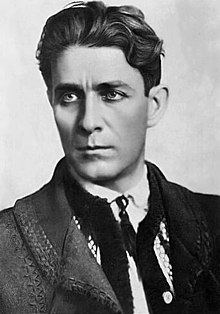
Back كورنليو زليا كودريانو Arabic Corneliu Zelea Codreanu AST Карнеліу Зеля Кадрану Byelorussian Корнелиу Кодряну Bulgarian Corneliu Zelea Codreanu Catalan Corneliu Zelea Codreanu Czech Corneliu Zelea Codreanu German Κορνέλιου Κοντρεάνου Greek Corneliu Zelea Codreanu Esperanto Corneliu Zelea Codreanu Spanish
Corneliu Zelea Codreanu | |
|---|---|
 | |
| Captain of the Iron Guard | |
| In office 24 June 1927 – May 1938 | |
| Succeeded by | Horia Sima (as "Commander") |
| Member of the Assembly of Deputies | |
| In office August 1932 – November 1933 | |
| Personal details | |
| Born | Corneliu Zelinski 13 September 1899 Huși, Fălciu County, Kingdom of Romania |
| Died | 30 November 1938 (aged 39) Tâncăbești, Snagov, Ilfov County, Kingdom of Romania |
| Cause of death | Extrajudicial execution |
| Resting place | Jilava, Ilfov County, Romania (1938–1940) Green House, Bucharest, Romania (1940–?) Unknown (present) |
| Political party | National-Christian Defense League (1923–1927) Iron Guard (1927–1938) |
| Spouse | |
| Alma mater | Alexandru Ioan Cuza University Grenoble Alpes University |
| Occupation | Politician |
| Profession | Lawyer |
| Known for | Founder and Leader of the Legionary Movement |
| Books | For My Legionaries |
| Religion | Romanian Orthodox |
| Part of a series on |
| Fascism in Romania |
|---|
 |
| Part of a series on |
| Antisemitism |
|---|
 |
|
|
Corneliu Zelea Codreanu[a] (Romanian: [korˈnelju ˈzele̯a koˈdre̯anu] ⓘ; 13 September 1899 – 30 November 1938), born Corneliu Zelinski and commonly known as Corneliu Codreanu, was a far-right Romanian politician, the founder and charismatic leader of the Iron Guard or The Legion of the Archangel Michael (also known as the Legionary Movement), an ultranationalist and violently antisemitic organization active throughout most of the interwar period. Generally seen as the main variety of local fascism, and noted for its mystical and Romanian Orthodox-inspired revolutionary message, the Iron Guard gained prominence on the Romanian political stage, coming into conflict with the political establishment and the democratic forces, and often resorting to terrorism. The Legionnaires traditionally referred to Codreanu as Căpitanul ("The Captain"), and he held absolute authority over the organization until his death.
Codreanu, who began his career in the wake of World War I as an anticommunist and antisemitic agitator associated with A. C. Cuza and Constantin Pancu, was a co-founder of the National-Christian Defense League and assassin of the Iași Police prefect Constantin Manciu. Codreanu left Cuza to find a succession of movements on the far right, rallying around him a growing segment of the country's intelligentsia and peasant population, and inciting pogroms in various parts of Greater Romania. Several times outlawed by successive Romanian cabinets, his Legion assumed different names and survived in the underground, during which time Codreanu formally delegated leadership to Gheorghe Cantacuzino-Grănicerul. Following Codreanu's instructions, the Legion carried out assassinations of politicians it viewed as corrupt, including Premier Ion G. Duca and his former associate Mihai Stelescu. Simultaneously, Corneliu Zelea Codreanu advocated Romania's adherence to a military and political alliance with Nazi Germany.
During the 1937 election, his party registered its strongest showing, placing third and winning 15.8% of the vote. It was blocked out of power by King Carol II, who invited the rival fascists and fourth-place finishers of the National Christian Party to form a short-lived government, succeeded by the National Renaissance Front royal dictatorship. The rivalry between Codreanu and, on the other side, Carol and moderate politicians like Nicolae Iorga ended with Codreanu's incarceration at Jilava Prison and eventual assassination at the hands of the Gendarmerie. He was succeeded as leader by Horia Sima. In 1940, under the National Legionary State proclaimed by the Iron Guard, his killing served as the basis for violent retribution.
Corneliu Zelea Codreanu's views influenced the modern far right. Groups claiming him as a forerunner include Noua Dreaptă and other Romanian successors of the Iron Guard, the International Third Position, and various neofascist organizations in Italy and other parts of Europe.
Cite error: There are <ref group=lower-alpha> tags or {{efn}} templates on this page, but the references will not show without a {{reflist|group=lower-alpha}} template or {{notelist}} template (see the help page).